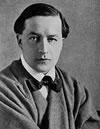
BL. W. B. Yeats
12. At the Hawk’s Well. In The Wild Swans at Coole. Churchtown, Dundrum: Cuala, 1917.
Written at Stone Cottage in Yeats’s initial flush of enthusiasm for the Japanese theatre, and dictated to Pound early in 1916 (see 74, p. 215), this ‘dance play’, about a defining moment in the life of the legendary Cuchulain (see also 14b, 35a, 44a, 168, and 227), is Yeats’s first attempt at a drama consciously patterned on the nô. Of conventions he associates with the form, several in use here may be found in his earlier drama—the dance of a supernatural being in Land of Heart’s Desire (2), a chorus of musicians and the playing upon central metaphors in Deirdre (5), legendary characters in spiritual conflict, a meeting of mortals with immortals, and a stylised, anti-naturalistic stage design in several earlier works—but in combination here with masks and costumes, designed by Edmund Dulac, Itô’s choreography (Ap), and a heightened sense of ritual—set in motion by an opening song in which the musicians ‘call to the eye of the mind’ the bleak setting while unfolding a cloth that marks the beginning of the play (it is folded again at the end)—the conventions coalesce into a drama that Yeats himself thought of as Irish nô (see 48f). Critics have differed in assessing the degree to which the work captures the effects of the nô, but many have found it close in spirit. Both Taylor (180) and Sekine (250) suggests a direct source in Fenollosa’s Yôrô (BK75); Miner (A25) argues that the work is ‘as close an emulation of Noh as [Yeats’s] limited knowledge and practical necessities allowed’; and Arnott (A44) finds in it ‘the purest noh style’ in Yeatsian drama. The work was first published under the title At the Hawk’s Well or Waters of Immortality in Harper’s Bazaar in March 1917. For other Yeats plays arguably indebted to his encounter with the nô see BL14a-b, 17a, 19a, 24a, 28, 34, 35a, 36a, 37b-c, 39, and 44a-b; and see also A32, BK56c, 59d, 81a, 86c, 144, 153, 185, BL11, 12a, 20a, 24b, 48, 48e, 48g-h, 60, 62, 64, 68, 70, 77, 81, 84, 86, 87, 90, 93, 99-102, 105, 106, 112, 113, 116, 119b, 120, 123, 131, 134, 138, 141, 142, 151, 154, 155, 158, 161, 164, 165, 167, 172, 174, 182, 183, 185, 192, 199, 201, 204, 205a, 208, 214, 216-19, 222, 226, 227, 230, 233, 236, 239, 247, 250, 252, 255, CA10, and D17a4. Reprinted in 17 and 20.
a. ‘A Note on At the Hawk’s Well’. Yeats describes his distress at setting forth his ‘muses’ on the stage only to have them ‘half-welcomed’, yet knows that he ‘need[s] a theatre’, and feels ‘most alive at the moment when a room full of people share the one lofty emotion’. In his new play he has resolved the problem, having found his ‘first model . . . in the “Noh” stage of aristocratic Japan’, that ‘most subtle stage’ that has taught him ‘to get rid of scenery, to substitute for a crude landscape painted upon canvas three performers who, sitting before the wall or a patterned screen, describe landscape or event, and accompany movement with drum and gong, or deepen the emotion of the words with zither or flute’. Includes discussion of the advantages of masked players and of a small audience of ‘those who care for poetry’. The attempt in plays based on these principles will be to ‘create once more heroic or grotesque types that, keeping always an appropriate distance from life, would seem images of those profound emotions that exist only in solitude and in silence’, and to provide dramatic expression to ‘the subtler forms of literature’. Dated December 1916. First appeared as a preface to the play in Harper’s Bazaar, March 1917; reprinted in whole or part as ‘Instead of a Theatre’, ‘Yeats on His Own Work’, and ‘Note on the first performance of At the Hawk’s Well’ (see Wade [82]).





